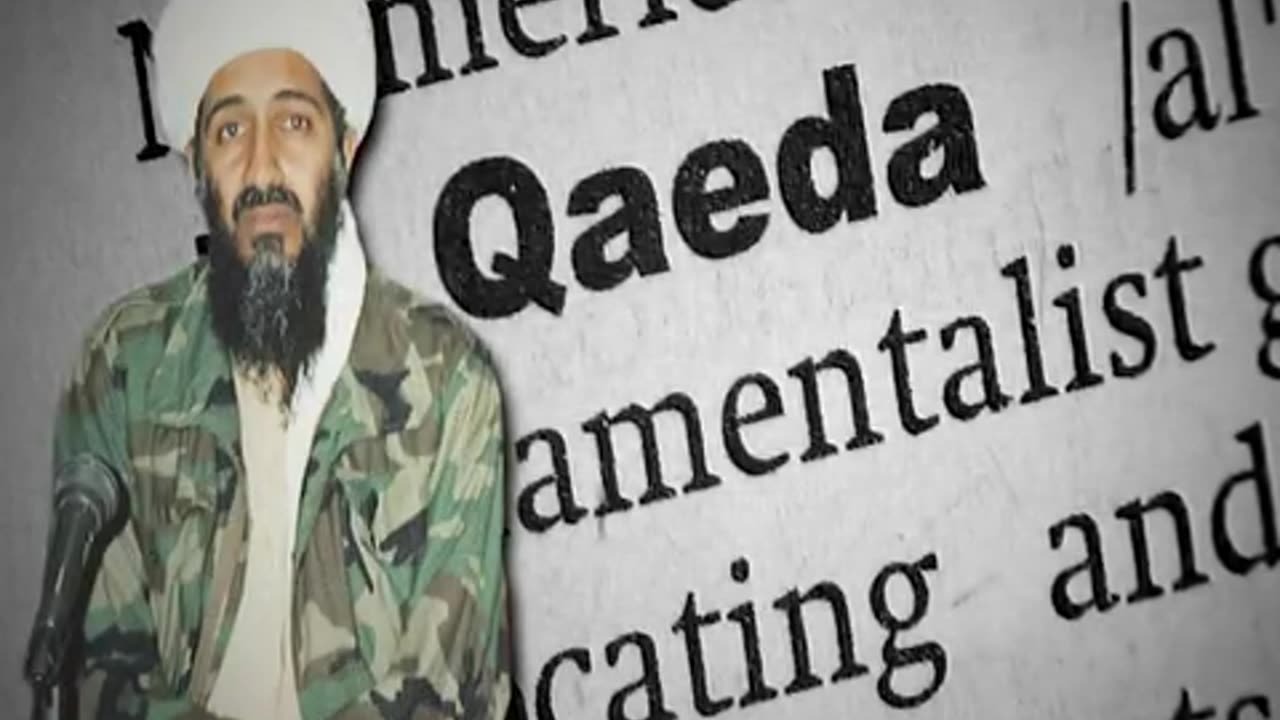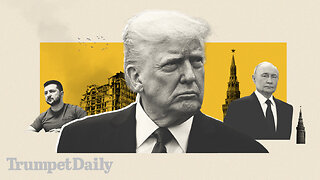Premium Only Content

False Flags: The Secret History of Al Qaeda
TRANSCRIPT
"Does the Brotherhood exist?"
"That, Winston, you will never know."
George Orwell
Nineteen Eighty-Four
INTRODUCTION
Kandahar Provice, Afghanistan. May 1998.
John Miller, an ABC News correspondent who would go on to become the FBI's chief spokesman, ends an 11-day journey through the wilds of the Afghanistan-Pakistan border. The first thing he notices is the rumbling of the generators providing the camp with power and the smell of gasoline. The second thing he notices is a hail of bullets. Bin Laden's convoy is arriving.
Osama bin Laden is flanked by seven bodyguards, who—as Miller immediately recognizes—are simply there to put on a show. "Their eyes darted in every direction for any attacker," he later recounted. "This was either merely theatrical or entirely pointless, because with hundreds of rounds being fired into the air, it would have been impossible to pinpoint an assassin."
Following the security detail into the hut, there Miller became one of the handful of Western journalists to interview the elusive Osama bin Laden.
OSAMA BIN LADEN (VIA INTERPRETER): We believe that the biggest thieves in the world are Americans and the biggest terrorists on earth are the Americans. The only way for us to fend off these assaults is by using similar means. We do not differentiate between those dressed in military uniforms and civilians; they're all targets in this fatwa.
SOURCE: Osama bin Laden: "The Most Dangerous Man You've Never Heard Of" - June 10, 1998 - ABC News Nightline
Miller has traveled halfway around the world to interview bin Laden, the reclusive terrorist leader who has just issued a religious fatwa requiring Muslims to kill Americans. But this interview, too, is just for show. Forced to submit his questions in writing ahead of time, Miller is informed that the answers will not be translated for him. There will be no follow-up questions.
It is spectacle. Theater and little else. As such, it is a fitting introduction to the man who would become the bogeyman of the 21st century. The interview was followed in short order by a more explosive drama.
PETER BERGEN: What are your future plans?
OSAMA BIN LADEN: You'll see them and hear about them in the media . . . God willing.
SOURCE: Exclusive Osama bin Laden - First Ever TV Interview
FALSE FLAGS: THE SECRET HISTORY OF AL QAEDA
PART ONE: ORIGIN STORY
Around the world, a frightened and confused public received their introduction to the age of terror on the morning of September 11, 2001, through the media. It was there, in the flickering images of their TV screens, that the masses began to learn about the world of Islamic terrorism and of the cave-dwelling Saudi exile in Afghanistan who was bringing that terror to their doorstep.
ANCHOR: Tell us a bit about Osama bin Laden—what sort of resources in manpower and money he's got and what he's trying to achieve.
SOURCE: September 11, 2001 - 5:28pm EDT (10:28pm BST)
RAY SUAREZ: What is Osama bin Laden? Is he a politician? Is he a warrior? Is he a preacher? A little of all?
SCHEUER: A little of all, I think, sir. He's a . . .
SOURCE: Who Speaks For Islam?
HODA KOTB: . . . millionaire Saudi businessman believed to be living in exile in Afghanistan.
SOURCE: September 11, 2001 - 5:20-5:30pm EDT on WRC
REPORTER: He controls and finances Al Qaeda, an umbrella network of Islamic militants.
SOURCE: September 11, 2001 - 6:30-6:40pm EDT (11:30-11:40pm BST) on BBC
SCHEUER: . . . he is a very soft-spoken man . . .
SOURCE: Who Speaks For Islam?
SIMON REEVE: . . . a man who is prepared to use overwhelming force in pursuit of his objectives.
SOURCE: September 13, 2001 - 6:21am EDT on CNN
ANCHOR: He is the face that has been put on this by almost everyone.
SOURCE: September 15, 2001 - 8:20-8:30am EDT on WTTG
SCHEUER: . . . a man of eloquence . . .
SOURCE: Who Speaks For Islam?
KOTB: He has declared all US citizens legitimate targets of attack.
SOURCE: September 11, 2001 - 5:25pm EDT on WRC
JOHN SIMPSON: When I was in Afghanistan just a couple of days ago, I heard that he had . . .
SOURCE: September 11, 2001 - 5:20-5:30pm EDT (10:20-10:30pm BST) on BBC
DAN RATHER: . . . operations in at least 55 countries . . .
SOURCE: CBS Evening News - 2001-09-13
KOTB: Including last year's bombing of the USS Cole in Yemen . . .
SOURCE: September 11, 2001 - 5:25pm EDT on WRC
REPORTER: . . . the mastermind behind the bombings of two US embassies in Africa . . .
SOURCE: September 16, 2001 - 11:30-11:40pm EDT on CNN
REPORTER: . . . and the last attack on the World Trade Center eight years ago.
SOURCE: September 11, 2001 - 6:20-6:30pm EDT (11:20-11:30pm BST) on BBC
SCHEUER: Bernard Lewis has called him almost a poetic speaker of Arabic.
SOURCE: Who Speaks For Islam?
KATIE COURIC: Meanwhile, Osama bin Laden is a name that we have been hearing all day long as an individual who may—and we emphasize may—be responsible for these terrorist acts. It is a name we have heard before as well . . .
SOURCE: NBC News 9-11-2001 Live Coverage 1:00pm EDT - 6:30pm EDT
We all know the story of bin Laden and Al Qaeda, the story that was repeated ad nauseam in the days, weeks and months after the catastrophic, catalyzing events of 9/11. So often was that story repeated that the hypnotized public forgot that it was, at base, just that: a story.
In the ahistorical fable of TV sound bites, terrorism is a modern invention—created out of whole cloth by Osama bin Laden and Al Qaeda. And, at the same time, Islamic fundamentalism is a force of nature, something that has always existed in the Middle East—the product, perhaps, of some sandstorm on the Arabian peninsula in the distant past.
But this is a lie. In truth, the rise of Islamic fundamentalism in the modern era and the rise of terrorism as a political tool cannot be understood without confronting some very well-documented but long-repressed history.
Ever since the mid-18th century—when the British East India Company gained dominion over the Indian subcontinent—the history of Islam as a political and cultural force has been intimately tied to the fortunes of Empire and the aims of the Western powers. The British Empire, in particular, did much to shape the map of the modern-day Middle East and to influence the course of its religious and political forces.
This influence can be seen throughout the 18th and 19th centuries.
Britain's gradual takeover of the Indian subcontinent led to the British Empire becoming, in the estimation of Winston Churchill, "[T]he greatest Mohammedan power in the world."
The 19th-century "Great Game" between Victorian England and Tsarist Russia for control of Central Asia saw the British propping up unpopular Islamic rulers throughout the region as a buffer between Russia and the "crown jewel" of the British Empire, India.
Britain's desire to maintain its access to India led to the British conquest of Egypt in 1882, resulting in 40 years of British rule and a military presence in the country that was not removed until the Suez Crisis of 1956.
From Khartoum to Constantinople, Jerusalem to Jakarta, no part of the Muslim world could escape the influence of the British crown. Sometimes that influence was used to strengthen the rule of Islamic hardliners. Sometimes, as with the Mahdist rebellion in Sudan, that influence was used to put down Islamic uprisings. But in each case, the British Empire's goal was clear: to use whatever means at its disposal to undermine movements and governments unfavourable to its rule and to install and encourage those forces that were willing to cooperate with the crown.
This was evident in India, where George Francis Hamilton, secretary of state for India, wrote in 1886 of the British strategy of using Muslim and Hindu divisions in the country to their advantage along the lines of the old Roman imperial strategy of divide and rule:
I think the real danger to our rule, not now, but say 50 years hence is the gradual adoption and extension of Western ideas of agitation organisation and if we could break educated Indians into two sections holding widely different views, we should, by such a division, strengthen our position against the subtle and continuous attack which the spread of education must make upon our system of government. We should so plan educational text-books that the differences between community and community are further strengthened.
But perhaps no clearer example of the British Empire's role in shaping the modern Muslim world can be found than the story of the ascendance of the House of Saud and the formation of the modern-day Kingdom of Saudi Arabia. Once again, British fingerprints can be found on every aspect of the story.
When Britain began contemplating a shift from its centuries-long policy of supporting the Ottoman Empire in the Middle East, it was Captain William Shakespear—a British civil servant and explorer—who made the first official contact with Ibn Saud, the progenitor of the Saudi dynasty who would go on to found the Kingdom of Saudi Arabia. In addition to taking the first photographs of the future Saudi king, Shakespear became Ibn Saud's friend and military advisor, helping to steer the rising Arab leader away from alliance with the Ottomans and into a treaty with the British. Shakespear died on the battlefield at Jarab in 1915, where the British-backed Ibn Saud was battling his Turkish-backed rival, Ibn Rashid.
After Shakespear's death, another British agent, Colonel Thomas Edward Lawrence, gained international fame as "Lawrence of Arabia" for his role in the Arab Revolt against Ottoman rule in the Middle East. Although his own self-serving autobiography and the Hollywoodization of his story cemented in the popular imagination the idea that Lawrence was motivated solely by his concern for the Arabs and their independence . . .
PETER O'TOOLE (AS T. E. LAWRENCE): We do not work this thing for Faisal.
ANTHONY QUINN (AS AUDA ABU TAYI): No? For the English then?
LAWRENCE: For the Arabs.
TAYI: The Arabs?
SOURCE: LAWRENCE OF ARABIA
. . . the documented history of Lawrence's actions and motivations tells a very different story. A memo on "The Politics of Mecca" penned by Lawrence for his intelligence handlers in 1916, reveals a more duplicitous British calculus for supporting certain factions of the Arab Revolt:
The Arabs are even less stable than the Turks. If properly handled they would remain in a state of political mosaic, a tissue of small jealous principalities, incapable of cohesion, and yet always ready to combine against an outside force. The alternative to this seems to be control and colonization by a European power other than ourselves, which would inevitably come into conflict with the interests we already possess in the Near East.
Later, in a report on the "Reconstruction of Arabia" Lawrence penned for the British Cabinet at the end of the war, he was even more explicit about the cynical divide-and-rule tactics at play in British support for the Arab Revolt: "When war broke out an urgent need to divide Islam was added, and we became reconciled to seek for allies rather than subjects. [. . .] We hoped by the creation of a ring of client states, themselves insisting on our patronage, to turn the present and future flank of any foreign power with designs on the three rivers."
ALEC GUINNESS (AS PRINCE FAISAL): Lawrence! . . . Or is it Major Lawrence?
LAWRENCE: Sir!
FAISAL: Ah. Well, General, I will leave you. Major Lawrence doubtless has reports to make. About my people. And their weakness. And the need to keep them weak . . . in the British interest.
SOURCE: LAWRENCE OF ARABIA
Lawrence and the military and diplomatic personnel of the British Empire were indeed busy in the wake of WWI. In many ways, the aftermath of the war represented the zenith of that empire, and the culmination of centuries of British manipulation in the Middle East. Driven by a mixture of political necessity and imperial hubris, the imperial planners had entered into secret agreements that redrew the map of the Middle East and once again affirmed the centuries-old accusation that Perfidious Albion was not to be trusted.
In 1916, the British and French entered into a pact to divide up the territory of the Ottoman Empire between themselves should they win the war. This treaty—known as the Sykes-Picot Agreement after the diplomats who negotiated the document—was a direct negation of the web of promises that the British had already made on the land, including the territorial promises they had made to Ali Ibn Husain, the Sherif of Mecca who led the Arab Revolt against the Turks, the Treaty of Darin that had promised Ibn Saud British protection for his conquests in the Arabian Peninsula in return for his support in the war, and the Balfour Declaration promising the Zionists a Jewish homeland in Palestine.
Although the revelation of the secret Sykes-Picot Agreement by the Bolsheviks in 1917 proved a considerable embarrassment for the British and French, it did little to hinder their plans. The agreement provided a basis for the ultimate partitioning of the Ottoman Empire after the war, and the national borders that it helped to create have gone on to shape a century of strife and political conflict in the region.
But it was not enough merely to draw the lines on the maps that would define the post-war Middle East, the British had to shape the development of the region in their own interest, creating entire nations in the process. In the Arabian Peninsula, they came to pin their hopes on Ibn Saud, whose sole focus on the conquest of Arabia, they calculated, would counteract the rise of a broader Pan-Islamic movement that could challenge Britain's supremacy in the region. As historian Mark Curtis writes in his book, Secret Affairs: Britain’s Collusion with Radical Islam:
The British government of India had feared British sponsorship of an Arab caliph who would lead the entire Muslim world, and the effects this might have on Muslims in India, and had therefore favoured Ibn Saud, whose pretensions were limited to Arabia.
The subsidy from the British upon which Ibn Saud relied in his quest to unite the peninsula, which stood at £5,000 a month at the end of the war, was raised to £100,000 a year in 1922 by then-Colonial Secretary Winston Churchill. Churchill recognized that Saud's fighters—the "Ikhwan," or brotherhood of hardliners and adherents to the strict Wahabbi sect of Islam—were "austere, intolerant, well-armed and bloodthirsty" and "hold it as an article of duty, as well as of faith, to kill all who do not share their opinions and to make slaves of their wives and children." So why, then, did the British support Saud and his men? "My admiration for him [Ibn Saud] was deep," Churchill later confessed, "because of his unfailing loyalty to us."
That loyalty paid off well. The British were the first to formally recognize Ibn Saud's sovereignty over his newly conquered territory on the peninsula, and in return Ibn Saud signed a treaty agreeing to stop his forces from attacking Britain's neighbouring protectorates. In 1932, Ibn Saud became King Saud of the newly-formed "Kingdom of Saudi Arabia." But even the nation's new name was British. It was George Rendel, head of the British Foreign Office's Eastern Department, who suggested it.
The British played similar games throughout the region, arming, funding and encouraging those who would work with them—including violent Islamic radicals—and undermining any potential challengers to British dominance.
In Palestine, the British pardoned Amin al-Husseini—who had been sentenced to 10 years in prison for his involvement in the 1920 Jerusalem riots—and appointed him the Grand Mufti of Palestine (a title invented by the British) on condition that he cooperate with the British authorities.
In Egypt, which became a British protectorate after WWI, the rise of the Muslim Brotherhood—an Islamist mass movement founded by Hassan al-Banna—was at times an explicit threat to the British military presence in the country. Nevertheless, its position as an alternative to both secular nationalism and communism—which Britain regarded as growing threats to its influence in the region—meant that the British were prepared to work with the Brotherhood against their common enemies, even covertly financing the group in 1942.
In Iraq, the British, concerned at unrest in their Mesopotamian mandate, aided Prince Faisal in becoming Faisal I, King of Iraq. Faisal—recommended by T. E. Lawrence, guided (at his own request) by British advisors and traveling at British expense—won a British-backed plebiscite to become the Iraqi king in 1921.
The extent of British influence over the region during the post-war period was, in retrospect, staggering. But the number of machinations, manipulations and shifting alliances that were required to keep this system of mandates, protectorates and puppet governments going was a sign that the British were not all-powerful. On the contrary. Their influence, and indeed their empire itself, was waning, soon to be replaced by the new rising world superpower, the United States.
The US did not even wait until the end of the Second World War and the dawn of Pax Americana to begin its own "diplomacy" with the Muslims in the region.
NEWSREADER: An American destroyer comes alongside a cruiser at Great Bitter Lake on the Suez Canal in Egypt. It brings Ibn Saud, king of the five million people of Saudi Arabia, to a conference with President Roosevelt, stopping off here on his return from the Crimea Conference. The destroyer has been decked out with red carpets for the monarch. This 800-mile trip marks the first time that King Ibn Saud has ever left his native land.
SOURCE: Roosevelt Meets Saud
President Franklin Roosevelt's meeting with King Ibn Saud aboard the USS Quincy on Egypt's Great Bitter Lake in February 1945 was no ordinary exchange of diplomatic pleasantries. King Saud's first foreign trip involved a number of unusual requests and special arrangements. The Saudis insisted on bringing a contingent of 48 men even though the Americans had said they could accommodate only 10. They insisted on sleeping in tents pitched on the ship’s deck rather than in the cabins provided. They insisted on bringing their own sheep, as the king believed that good Muslims eat only freshly slaughtered animals.
But, irregularities aside, the meeting was momentous.
Firstly, it demonstrated the importance of the Saudi-US relationship at a time when much of the world knew little and cared less about the happenings on the Arabian peninsula.
Secondly, it established the terms of that relationship: namely, a US guarantee of military defense of Saudi Arabia (including Roosevelt's promise to "do nothing to assist the Jews against the Arabs") in return for Saudi concessions, including allowance for US airfields and flyover routes across the kingdom and access to Dharhan, where the California Arabian Standard Oil Corporation (which later became Aramco) had drilled the first commercially viable oil well in the country just seven years earlier.
And thirdly, it signaled the dawn of a new era. No longer was the British Empire the primary foreign power driving events in the region. From now on, one of the key foreign policy considerations of the Muslim world was the US and its enormous military and financial resources.
This changeover in world order was not instantaneous. For some time after the end of WWII, the US and British collaborated on operations that furthered their mutual interests in the region. These "interests" included opposing the rising threat of secular nationalist governments that—unlike the House of Saud and other Western-backed monarchies in the Middle East—were less pliable to bribes and more interested in nationalizing their countries' resources.
In March 1951, the Iranian parliament voted to nationalize the Anglo-Iranian Oil Company—the British oil giant that struck oil near the Persian Gulf in 1908—and offered the premiership of the government to Mohammed Mossadegh, an outspoken secular nationalist. Immediately after taking office, Mossadegh effected the nationalization, stating:
Our long years of negotiations with foreign countries [. . .] have yielded no results this far. With the oil revenues we could meet our entire budget and combat poverty, disease, and backwardness among our people. Another important consideration is that by the elimination of the power of the British company, we would also eliminate corruption and intrigue, by means of which the internal affairs of our country have been influenced. Once this tutelage has ceased, Iran will have achieved its economic and political independence.
The nationalization put Tehran on a collision course with London. But Britain knew that a military intervention was not possible without American approval and, despite harsh economic sanctions on the country and a boycott of the newly nationalized oil industry that was joined by much of the Western world, they could not overthrow the Iranian government themselves. Instead, they had to turn to the US.
Although the Truman administration was initially hesitant to become involved, that changed with the election of Dwight D. Eisenhower and the installation of the Dulles brothers, Allen and John Foster, as Director of Central Intelligence and Secretary of State respectively. By June of 1953, the CIA was already adapting the British coup proposal into their own covert operation, dubbed Operation TPAJAX.
An open secret in the world of intelligence, the CIA/MI6 role in the overthrow of Mossadegh was officially denied by the US government for over half a century and is still unacknowledged by the British government to this day. Nevertheless, the CIA's own internal history of the operation, first revealed to the public in the year 2000, confirms the extent of the American and British role in the coup.
They convinced the Shah of Iran to agree to the plan. They handpicked General Fazlollah Zahedi as Mossadegh's successor. They rolled out a propaganda campaign to portray Mossadegh—a devout adherent to democratic nationalism who rigorously excluded the nation's communist party from his government—as a communist sympathizer who would steer Iran into the arms of the Soviets; they spent hundreds of thousands of dollars bribing journalists, clerics, and even Iranian parliament members themselves to go along with the plot; and they used a network of agents and suitcases full of money to incite riots and protests across the country.
In the end, the operation was a success. Mossadegh was driven from power, General Zahedi took his place, the Western-backed Shah ruled the country with the iron fist of his feared secret police for the next 25 years, and a new agreement on sales of Iranian oil was reached. This time, though, the Anglo-Iranian Oil Company, now rebranded as British Petroleum, would not have a monopoly on the country's lucrative oil reserves; an international consortium was put together to share in the profits, with American companies Chevron and Standard Oil cut into the deal.
But the eclipse of the old British Empire by the new American superpower became most obvious in Egypt during the Suez Crisis of 1956.
Lying on the key spice and trade routes linking Europe and Asia, the importance of Egypt to the British Empire went back centuries. It was the British Navy under Nelson and the British Army under General Ralph Abercromby that drove Napoleon out of the country during the French campaign there at the turn of the 19th century. But it was the opening of the Suez Canal in 1869 that cemented Egypt's geopolitical importance for the British Empire.
The Suez Canal—linking the Mediterranean Sea to the Red Sea and drastically reducing sailing distances from Asia to Europe—was technically the property of the Egyptians, but the project had been spearheaded by the French, and the concessionary company that operated the canal had been largely financed by French shareholders. An economic crisis in 1875, however, forced the Egyptian governor to sell his own shares to the British. As Parliament was not in session at the time of the sale, British Prime Minister Benjamin Disraeli had to turn to his close personal friend, Lionel de Rothschild, for the £4,000,000 required to purchase the shares. After the British conquest of Egypt in 1882, an international agreement was signed declaring the canal a neutral zone under the protection of the British, whose troops were now installed in the country.
This precarious balance of power lasted in various permutations for over 70 years, first under Britain's so-called "Veiled Protectorate" of Egypt in the decades leading up to WWI, then in a formal British occupation of the country during WWI and its aftermath, and then under Britain's Unilateral Declaration of Egyptian independence in 1922, which stipulated that the British would retain power over Egypt's defence and foreign policy. Britain's de facto control over the country was one of the grievances that gave rise to the Free Officers Movement, a cadre of Egyptian nationalists in the ranks of the Egyptian Armed Forces who toppled King Farouk and took over the government in the Egyptian Revolution of 1952.
One of the movement's leaders, Gamal Abdel Nasser Hussein, became President of Egypt in 1954 and began to implement a series of nationalist, anti-imperialist measures that, like Mossadegh, put him at odds with the British forces in his country. These measures culminated with Nasser's nationalization of the Suez Canal on July 26, 1956.
The Suez Crisis led to a joint British-French-Israeli invasion of the country, but in this case, the US under Eisenhower declined to back the invasion. Instead, Eisenhower—still believing that diplomacy and pressure could turn Nasser from the Soviet orbit and help America leverage its influence over the Arab world—joined the USSR in forcing an end to the invasion.
The crisis marked a definitive turning point. The age of the British Empire were over. The age of the American superpower had begun. From now on, American military and financial power would be the determining factor in the Muslim world—and indeed the world in general.
But the Americans had learned well from their British predecessors. The same tactics of strategic and shifting alliances, double dealings and covert operations that the British had used to maintain their influence for centuries would now be employed by the Americans to leverage their own power.
They applied these lessons in Iran, where they supported the Shah's brutal dictatorship even as they maintained a secret communication channel with exiled religious leader Ayatollah Khomeini.
They applied these lessons in Indonesia, where the US at various times supported the Islamic factions in their rebellion against the Sukarno government, the Sukarno government itself, and, eventually, Suharto, who slaughtered over half a million people on his US-backed rise to power.
They applied these lessons in the Sinai Peninsula, where, as declassified documents now show, US Secretary of State Henry Kissinger helped engineer the Yom Kippur War so that "the Arabs would conclude the only way to peace was through us" and the Israelis would conclude that "they had to depend on us to win and couldn't win if we were too recalcitrant."
And they applied these lessons in Saudi Arabia, where Treasury Secretary William Simon helped enshrine the US dollar's central role in global geopolitics and saved the US from the 1973 oil crisis by negotiating the petrodollar system, a covert deal with the House of Saud to purchase Saudi oil and sell them weapons and equipment in return for a Saudi pledge to finance American debt by investing their oil revenue in US Treasuries.
This era of American-led intrigue and double-dealing would culminate in one of the most important years for the Muslim world in the modern era: 1979.
That was the year of the Iranian revolution, when the American and British overthrow of Mossadegh in 1953 would come home to roost in the overthrow of the Western-backed Shah and the first major victory for the forces of political Islam in the creation of the Islamic Republic of Iran.
That was the year of the seizure of the Grand Mosque in Mecca, when Islamic hardliners shocked the Muslim world by storming the holiest mosque in Islam and, during a dramatic two-week standoff, calling for the overthrow of the House of Saud and the end of its attempts at westernization.
That was the year Egyptian President Anwar Sadat signed a peace treaty with Israel, normalizing relations between the two countries and leading to Sadat's assassination by members of Egyptian Islamic Jihad just two years later.
And that was also the year that developments in Afghanistan put in motion a chain of events that would lead to the creation of the group we now know as "Al Qaeda."
On Christmas Eve 1979, Soviet troops began an invasion of Afghanistan. Initially, this was portrayed to the American public as a spontaneous act of aggression, the opening salvo in a new campaign by the Russians to conquer the region and upset the world order.
JIMMY CARTER: Fifty thousand heavily armed Soviet troops have crossed the border and are now dispersed throughout Afghanistan, attempting to conquer the fiercely independent Muslim people of that country.
[. . .]
If the Soviets are encouraged in this invasion by eventual success, and if they maintain their dominance over Afghanistan and then extend their control to adjacent countries, the stable, strategic, and peaceful balance of the entire world will be changed.
SOURCE: January 4, 1980: Speech on Afghanistan
As historians with access to USSR document archives now know, the Soviet leadership was extremely reluctant to become entangled in Afghanistan. Well aware of the country's reputation as a "graveyard of empires," Soviet politicians and military leaders knew that any attempt to bring Afghanistan under military and political control would be extremely difficult.
Instead, the invasion was the end result of a series of events that threatened to plunge Afghanistan and the surrounding region into chaos.
Starting in the wake of WWII, the urban, cosmopolitan political elite of the rural and agrarian nation of Afghanistan began a series of reforms and development projects that, they hoped, would bring their country into the modern era. Seeking assistance in this task, these leaders turned to the USSR, who, in addition to providing $100 million in low-interest credit to finance the projects, also welcomed members of the country's political and military elite for training at Soviet institutions. In turn, these young Afghan elites brought communism back to their country.
The Afhgan communists supported a bloodless coup in Kabul in 1973, overthrowing the king and instituting a one-party state whose government included representation by the People's Democratic Party of Afghanistan (PDPA), a pro-Soviet, Marxist-Leninist party that boasted ties to the Afghan National Army. But the PDPA, frustrated by a perceived lack of progress toward communist goals on the part of this new government, precipitated another coup in 1978. This new communist government, led by Nur Muhammad Taraki, presided over a period of dramatic reform: Land reforms sought to limit how much land a family could own; social reforms abolished Shariah law, began education of women, and sought to end forced marriage and other traditional practices; and political dissidents were rounded up and resistant villagers massacred.
Violently opposed both by the Islamic fundamentalists and conservatives in the country as well as opposing factions within his own party, Taraki was overthrown in September of 1979 and killed the following month. Taraki's sucessor and one-time protege, Hafizullah Amin, led an even shorter and more turbulent government. Taking over the presidency in September, Amin—who, the Russians feared, was seeking to improve Afghanistan's relations with the United States—was deposed when Soviet forces entered the country and assassinated him on December 27th, 1979.
The official history—written by the CIA, echoed by the US State Department and propounded in Hollywood productions—maintains that the US response to the events in Afghanistan—a response that would go on to include billions of dollars in arms, funds and training for the Islamic resistance to the Soviet forces—began after the Soviet invasion in 1979.
TERRY BOZEMAN (AS "CIA AWARD PRESENTER"): The defeat and breakup of the Soviet empire, culminating in the crumbling of the Berlin Wall, is one of the great events of world history. There were many heroes in this battle, but to Charlie Wilson must go this special recognition.
Just 13 years ago, the Soviet Army appeared to be invincible. But Charlie, undeterred, engineered a lethal body blow that weakened the Communist empire. Without Charlie, history would be hugely and sadly different.
And so, for the first time, a civilian is being given our highest recognition, that of Honored Colleague. Ladies and gentlemen of the Clandestine Services, Congressman Charles Wilson.
SOURCE: Charlie Wilson's War
But this, too, is a lie. In reality, the covert operation to aid the mujahideen "freedom fighters" did not begin after the Soviets invaded, and it was not the work of Charlie Wilson.
As former CIA director Robert Gates revealed in his 1996 autobiography, assistance to the Afghan mujahideen did not start after the Soviet invasion, but six months before, in July 1979, with President Jimmy Carter signing off on a covert operation to assist and fund the resistance forces in Afghanistan. This was done in the full knowledge that these forces might antagonize and draw the Soviets into the country, which is precisely what a certain faction of the Carter White House—known as "the bleeders" for their propensity to "bleed" the Soviet Union through an engaged guerrilla conflict like the US had experienced in Vietnam—wanted to achieve.
This was confirmed two years later by Zbigniew Brzezinski, Carter's National Security Advisor, in a 1998 interview:
According to the official version of history, CIA aid to the mujahideen began during 1980, that is to say, after the Soviet army invaded Afghanistan on December 24, 1979. But the reality, closely guarded until now, is completely otherwise: Indeed, it was July 3, 1979 that President Carter signed the first directive for secret aid to the opponents of the pro-Soviet regime in Kabul. And that very day, I wrote a note to the president in which I explained to him that in my opinion this aid was going to induce a Soviet military intervention.
The program that Carter signed off on—dubbed Operation Cyclone and billed as "the largest covert operation in history"—continued and expanded throughout the 1980s, leading to the rise of the Taliban and the encouragement of what Brzezinski called in that same interview "some agitated Muslims."
KENNETH BRANNAGH: US National Security Advisor Brzezinski flew to Pakistan to set about rallying the resistance. He wanted to arm the mujahideen without revealing America's role. On the Afghan border near the Khyber Pass, he urged the "Soldiers of God" to redouble their efforts.
ZBIGNIEW BRZEZINSKI (in Pakistan): We know of their deep belief in God and we are confident that their struggle will succeed. That land over there is yours. You'll go back to it one day because your fight will prevail. And you'll have your homes and your mosques back again, because your cause is right and God is on your side.
BRZEZINSKI (interview): The purpose of coordinating with the Pakistanis would be to make the Soviets bleed for as much and as long as is possible.
SOURCE: Soldiers of God (Episode 20)
News of the struggle began to spread throughout the Arab world, and soon the stories of the brave mujahideen fighting the communist infidels became a rallying cry for jihad. The Afghan resistance had made Peshawar, just over the border in Pakistan, their headquarters, and it was there that visitors from around the Muslim world heard first-hand the tales from the battles against the Soviets and saw for themselves the squalor of the refugees who had been forced from their homes by the Russian invaders.
One such visitor was Abdullah Azzam, a passionate young Palestinian whose militant activism had cost him his job as a lecturer at King Abdulaziz University in Jeddah and had prompted him to take a position in Islamabad so he could be closer to the Afghan jihad. But this was still not close enough, and he resigned his position to dedicate himself full time to the Afghan cause. He spent time in the refugee camps and mujahideen base at Peshawar, issued a fatwa arguing that Muslims had a duty to wage jihad in Afhganistan, and made frequent trips to Jeddah, where he recruited young Muslims for the cause. While in Jeddah, he stayed at the guest flat of a rich young Saudi named Osama bin Laden.
Osama bin Laden was the 17th of 54 children of Mohammed bin Awad bin Laden, an itinerant laborer from Yemen who had worked his way up in the Saudi construction industry to become one of the wealthiest non-royals in the Saudi kingdom. Mohammed bin Laden's business— today known as the Binladin Group Global Holding Company and comprising a sprawling, multibillion-dollar multinational conglomerate involved in some of the largest construction projects in the world—started from humble beginnings.
After arriving in Jeddah from his native Yemen in 1930, Mohammed bin Laden took a job as a dockworker, then as a bricklayer for Aramco during the country's first oil boom. When Aramco sought to subcontract some of the construction work it had undertaken for the Saudi government, bin Laden used the opportunity to grow his own construction firm. His exacting building standards, combined with his energy, his honesty and his willingness to work shoulder-to-shoulder with his men, earned Mohammed bin Laden a reputation as a craftsman and a teacher and brought him to the attention of King Ibn Saud's finance minister.
The aging King Saud, by now largely confined to a wheelchair, gave bin Laden the chance to renovate his palace in Jeddah so that his car could be driven by ramp directly to his second-floor bedroom. Impressed with bin Laden's work (and bin Laden's gesture of personally driving the king's car up the newly installed ramp to make sure it would hold the weight), the king awarded him with a number of increasingly important projects and even appointed him as an honorary minister of public works. Bin Laden's business, later rebranded as the Saudi Binladin Group, would go on to construct most of the kingdom's roads, renovate the Prophet's Mosque at Medina and even renovate the Grand Mosque in Mecca itself.
Although Mohammed bin Laden's fortune was split between dozens of heirs, and although Osama's father divorced his mother shortly after he was born, the younger bin Laden was still born into a life of luxury that few in the kingdom outside the royal family would ever know. Osama bin Laden's share of the family fortune has been estimated at $30 million, and it was expected that he would, like many of his brothers, take up the family business. He studied economics and business administration at King Abdulaziz University, where he met and was influenced by Abdullah Azzam, who was by then was already known for his credo "Jihad and the rifle alone: no negotiations, no conferences, and no dialogues."
Accounts of when and how Osama bin Laden first ended up in Afghanistan differ. According to Osama himself, speaking to Robert Fisk in his first interview for the Western press in 1993: "When the invasion of Afghanistan started, I was enraged and went there at once - I arrived within days, before the end of 1979." Others contend that Osama had never heard of Afghanistan before the Soviet invasion and that he didn't set foot in the country itself until 1984.
Whatever the case, by the mid-1980s bin Laden was well-known as one of the key fundraisers for the Afghan cause in the Arab world, using his family connections to gather donations from rich Saudis and delivering them to Pakistan to assist the fighters in the field. In 1984, Osama and Azzam co-founded Maktab al-Khidamat (MAK), or the "Office of Services," which the US government would later identify as "the precursor organization to Al Qaeda." The group aimed to recruit the foreign fighters that were taking up Azzam's call to join the jihad in Afghanistan, with bin Laden providing money through his fundraising connections and with direct contributions.
Initially little more than a guest house in Peshawar where foreign recruits for the Afghan war could stop on their way to the front, the operation quickly expanded as money poured in and more fighters began to arrive. Soon it caught the attention of other figures in the Afghan war, including Gulbuddin Hekmatyar—a brutal Afghan warlord supported by the US to the tune of $600 million who was known for killing more Afghans than Soviets—and Dr. Ayman Al-Zawahiri, the head of Egyptian Islamic Jihad who would go on to become Osama bin Laden's right-hand man.
The New Yorker has called Zawahiri "The Man Behind Bin Laden." Syed Saleem Shahzad, a Pakistani journalist with access to senior Al Qaeda commanders, has argued it was Zawahiri, not the "figurehead" bin Laden, who "formulated the organization’s ideological line and devised operational plans."
Born in a suburb of Cairo in 1951 to a distinguished middle-class family, Zawahiri went on to study medicine at Cairo University, eventually earning a master's degree in surgery and serving three years as a surgeon in the Egyptian Army before establishing his own clinic. He wore Western dress, avoided the radical Islamist activism sweeping campus in his university days, and, according to one Westerner who met him in the mid-1970s, didn't talk or act like "a traditional Muslim."
But, we are asked to believe, this was all a front. In fact, according to the authors of the officially sanctioned history of Al Qaeda, Zawahiri was a lifelong radical who had joined the Muslim Brotherhood in 1965 at the tender young age of 14 and was set on his path toward violent jihad the next year, after the execution of the Brotherhood's then-leader, Sayyid Qutb.
Qutb was famous for his role in inspiring a generation of radical Muslims—including Azzam, Osama and Zawahiri—to take up violent jihad against the West and the forces of modernity in the creation of a new caliphate. Less remembered is Qutb's assertion that —during the 1960s, when Saudi King Faisal was openly conspiring with the CIA and Aramco to stir up anti-socialist Muslim groups and undermine Pan-Arabism and Arab nationalism—"America made Islam."
The then-15-year-old Zawahiri, we are told, responded to Qutb's execution by helping to "form an underground militant cell dedicated to replacing the secular Egyptian government with an Islamic one." By the late 1970s, a number of these cells had merged into a larger militant organization, Egyptian Islamic Jihad, which, incensed by President Anwar Sadat's signing of a peace treaty with Israel, assassinated him during a military parade on October 6, 1981.
Zawahiri was one of over 300 militants rounded up in the wake of the assassination and—having the best command of English among the defendants—became their spokesman for the international press.
PRISONER: For the whole world, this is our word by Dr. Ayman Zawahiri.
AYMAN AL-ZAWAHIRI: Now we want to speak to the whole world. Who are we? Who are we? Why did they bring us here? And what we want to say? About the first question: We are Muslims. We are Muslims who believe in their religion. [inaudible] We believe in our religion, both in ideology and practice, and hence we tried our best to establish an Islamic state and an Islamic society!
SOURCE: The Power of Nightmares Pt. 1
Before being arrested, Zawahiri had already spent some time in Peshawar, seeing firsthand the squalor of the refugee camps and even crossing the border into Afghanistan to witness the fighting itself. After his release from prison in Egypt in 1984, Zawahiri made his way to Jeddah and then back to Peshawar.
Thus, by the mid-1980s, all of the main characters that were associated with the rise of modern Islamic terror and the founding of Al Qaeda—Azzam, Osama, Zawahiri and their early associates—were now directly involved in the war in Afghanistan. They were not a single, cohesive group—Azzam and Zawahiri were rivals for Osama's funds and attention, with Zawahiri even spreading rumours among the mujahideen that Azzam worked for the Americans. But together, they formed the backbone of what would come to be called the "Afghan Arabs," an inaccurate term for all of the foreign jihadis who came to fight in Afghanistan, both Arab (including Saudis recruited by Osama and Egyptian members of Zawahiri's Islamic Jihad group) and non-Arab (Turks, Malays and others from across the Muslim world).
The Afghan Arabs were not the main fighting force in Afghanistan. In fact, some argue they were almost totally irrelevant to the fight; making up only a small percentage of the total mujahideen, they often got into quarrels with the Afghan fighters and were responsible for almost no significant victories in the struggle against the Soviets. But the story of these "holy warriors" who had answered the call of jihad spread throughout the Muslim world, helped in no small part by their own propensity for self-promotion. Azzam launched Al-Jihad Magazine to help publicize the Afghan Arabs' exploits and, with Osama's funding behind him, was able to make it an international concern. Distributed in America by the Islamic Centre in Tucson, Arizona, the magazine sold thousands of copies per month in the US alone.
But for some time there has been debate about the nature of the US role in fostering and funding the Afghan Arabs. While historians, scholars and journalists agree that CIA funding for the Afghan jihad—estimated to be well over $3 billion—did find its way to the Arab fighters, it has long been debated whether there was any direct contact between American intelligence and Osama bin Laden.
In the officially sanctioned history of the Afghan-Soviet War, the Americans were aiding the people of Afghanistan, brave "freedom fighters" who were engaged in a heroic struggle against the evil Soviet Empire.
RONALD REAGAN: The fact that freedom is the strongest force in the world is daily demonstrated by the people of Afghan. Accordingly, I am dedicating on behalf of the American people the March 22nd launch of the Columbia to the people of Afghanistan.
SOURCE: Afghanistan Day Proclamation Speech
REAGAN: The support that the United States has been providing the resistance will be strengthened, rather than diminished, so that it can continue to fight effectively for freedom. A just struggle against foreign tyranny can count upon worldwide support, both political and material. t
[. . .]
On behalf of the American people, I salute chairman Kalis, his delegation and the people of Afghanistan themselves.
[Applause]
You are a nation of heroes.
SOURCE: President Reagan's Remarks After a Meeting With Afghan Resistance Leaders on November 12, 1987
RICHARD CRENNA (AS SAM TRAUTMAN): Hard to believe, John.
SYLVESTER STALLONE (AS JOHN RAMBO): What's that, sir?
TRAUTMAN: Well, I hate to admit it, but I think we're getting soft.
RAMBO: Maybe just a little, sir. Just a little.
[CAPTION: THIS FILM IS DEDICATED TO THE GALLANT PEOPLE OF AFGHANISTAN.]
SOURCE: RAMBO III
This is the story propounded by the final report of the 9/11 Commission, which holds that the covert aid supplied for the operation by the United States went to Pakistan, who then distributed the funds and supplies directly to the Afghan fighters, not the Afghan Arabs. "Saudi Arabia and the United States supplied billions of dollars worth of secret assistance to rebel groups in Afghanistan fighting the Soviet occupation," the 9/11 Commission explained in the section of its report dedicated to "The Rise of bin Laden and Al Qaeda." "This assistance was funneled through Pakistan: the Pakistani military intelligence service (Inter-Services Intelligence Directorate, or ISID), helped train the rebels and distribute the arms. But bin Laden and his comrades had their own sources of support and training, and they received little or no assistance from the United States."
Here the 9/11 Commission is in agreement with Zawahiri himself, who insisted in his 2001 book, Knights Under the Prophet's Banner, that "the United States did not give one penny in aid to the mujahideen." After all, he adds: "If the Arab Afghans are the mercenaries of the United States who have now rebelled against it, why is the United States unable to buy them back now?"
Zawahiri's rhetorical question has not always been answered in the way he intended it. In fact, numerous sources over the years have pointed to just such direct contact between the US and the Afghan Arabs—and even between the CIA and Osama bin Laden himself.
There was Ted Gunderson, for example, a 27-year veteran of the FBI who claimed to have met bin Laden at the Hilton Hotel in Sherman Oaks, California, in 1986. Osama, Gunderson says, was introduced under the name "Tim Osman" and was in the midst of a US tour with a State Department handler, looking to procure weapons and support for the Afghan jihad. The only document that ever emerged to back this story up, however, was a crude, self-typed, single-page memo of unknown origin that only serves to throw an already dubious story into even further doubt.
Or there was journalist Joseph Trento's claim in his 2006 book, Prelude to Terror: The Rogue CIA and the Legacy of America’s Private Intelligence Network, that "CIA money was actually funneled to MAK, since it was recruiting young Muslim men to come join the jihad in Afghanistan." That claim, however, comes from a "former CIA officer" who couldn’t be identified because "at the time of the writing of this book, he was back in Afghanistan as a private contractor."
Or there was Simon Reeve, who wrote The New Jackals—the first book on Al Qaeda—in 1998. In it, he states that US agents "armed [bin Laden's] men by letting him pay rock-bottom prices for basic weapons." This claim, too, sources to an anonymous former CIA official.
In 2000, The Guardian reported on "Bin Laden: the question facing the next US president," stating flatly: "In 1986 the CIA even helped him [bin Laden] build an underground camp at Khost, where he was to train recruits from across the Islamic world in the business of guerrilla warfare." No source is provided for the claim, however.
In 2003, MSNBC Senior Correspondent Michael Moran wrote that: "Bin Laden, along with a small group of Islamic militants from Egypt, Pakistan, Lebanon, Syria and Palestinian refugee camps all over the Middle East, became the 'reliable' partners of the CIA in its war against Moscow." However, he conceded that "It should be pointed out that the evidence of bin Laden’s connection to these activities is mostly classified."
Supporters of the official story, however, make a valid point: of all the things that the multimillionaire heir to the bin Laden family fortune needed on his rise to international infamy, money was not one of them. No, what bin Laden needed for his burgeoning terror group to thrive was not more money; it was protection.
As he turned from "Anti-Soviet warrior" to international terror mastermind, bin Laden needed officials to look the other way as his people moved across borders. He needed routine security procedures to be abandoned at key moments. He needed intelligence agencies to disconnect the dots and fail to act on information at their disposal. When members of his organization got caught, he needed strings to be pulled so his associates could continue their operation.
And, as we shall see, this is precisely the type of protection that Osama bin Laden and his associates were to receive time and again in the coming decades.
Regardless of direct western intelligence involvement in the arming, funding or training of Maktab al-Khidamat, the question soon became a moot point. As the Afghan war was drawing to its inevitable conclusion and the Soviets prepared to march back to Moscow, Osama bin Laden was already planning a new group to consolidate his international network of mujahideen and to take the jihad global.
According to documents obtained from a March 2002 raid of the Sarajevo offices of Benevolence International Foundation—a not-for-profit humanitarian relief organization that was declared a financier of terrorism in the wake of 9/11—the original idea for the founding of Al Qaeda was discussed in a meeting on August 11, 1988. In attendance at the meeting: Osama bin Laden, Mohamed Atef—an Egyptian engineer and member of Zawahiri's Egyptian Islamic Jihad who would go on to become Al Qaeda's military commander—Jamal al-Fadl, a Sudanese militant recruited for the Afghan war from the MAK's US headquarters in Brooklyn, and a dozen others.
There are conflicting stories about the origin of the name "Al Qaeda," which means "the base" in Arabic. Bin Laden claims that "Al Qaeda" was simply the name used for the mujahideen training camps and "the name stayed." Others attribute it to Abdullah Azzam, who published a brief article in al-Jihad Magazine in April 1988, entitled "al-Qa’ida al-Subah," or, "The Solid Base," in which he wrote:
For every invention there must be a vanguard (tali’a) to carry it forward and, while forcing its way into society, endure enormous expenses and costly sacrifices. There is no ideology, neither earthly nor heavenly, that does not require such a vanguard that gives everything it possesses in order to achieve victory for this ideology. It carries the flag all along the sheer endless and difficult path until it reaches its destination in the reality of life, since Allah has destined that it should make it and manifest itself.
This vanguard constitutes the solid base (al-Qa’ida al-Subah) for the expected society.
In 2005, former British Foreign Secretary Robin Cook claimed that Al Qaeda was literally "the database," that is, "the computer file of the thousands of mujahideen who were recruited and trained with help from the CIA to defeat the Russians." He did not, however, provide proof for this claim, evidence of the existence of such a database itself, or an explanation of how he knew this information.
The founding document itself mentions "Al Qaeda Al Askariya" ("the Military Base"), explaining that: "The mentioned Al Qaeda is basically an organized Islamic faction, its goal will be to lift the word of God, to make his religion victorious."
It lists the "Requirements to enter Al Qaeda":
Members of the open duration.
Listening and obedient.
Good-manners.
Referred from a trusted side.
Obeying statutes and instructions of Al Qaida. These are from the rules of the work.
It gives the pledge for new members:
The pledge of God and his covenant is upon me, to listen and obey the superiors, who are doing this work, in energy, early-rising, difficulty, and easiness, and for his superiority upon us, so that the word of God will be the highest, and His religion victorious.
And it ends by noting that there were "thirty brothers in Al Qaeda, meeting the requirements, and thank God."
The meeting was noted by no one. In the larger scheme of things, it meant nothing. A ragtag band of thirty fighters, even if that ragtag band was led and financed by a Saudi millionaire, could accomplish very little on their own, and in the wake of the seismic forces taking place in Afghanistan at the time, it did not even register as a blip on the radar of anyone in the region. But the assistance and protection that would help steward this group of jihadi miscreants into a brand name for international terror was already in effect.
The early glimmers of this protection could be seen in Maktab al-Khidamat's efforts to recruit and train mujahideen for the Afghan jihad in the US. Starting in Tucson, Arizona, MAK would go on to open 30 branches in cities across the US, including their most important location, the Al Kifah Refugee Center based out of Brooklyn's Faruq Mosque. The CIA's role in aiding MAK and Al Kifah in their recruitment efforts has been an acknowledged fact for decades.
In 2001, Newsweek called the center "a dreary inner-city building that doubled as a recruiting post for the CIA seeking to steer fresh troops to the mujahideen."
In 1995, New York Magazine explained: "The highlight for the centre’s regulars were the inspirational jihad lecture series, featuring CIA-sponsored speakers. One week on Atlantic Avenue, it might be a CIA-trained Afghan rebel travelling on a CIA-issued visa; the next, it might be a clean-cut Arabic-speaking Green Beret, who would lecture about the importance of being part of the mujahideen."
J. Michael Springmann, a visa officer at the US Consulate in Jeddah from 1987 to 1989, testified how his decisions to deny visas to enter the United States to clearly unqualified applicants were routinely overridden by CIA officers at the consulate as part of their effort to "help Osama bin Laden's mujahideen in Afghanistan."
J. MICHAEL SPRINGMANN: I was being pressured by the Consul, General Jay Philip Freres, by a consular officer—I'm sorry, not a consular officer, a commercial officer—and various other people throughout the consulate: "We need a visa for this guy."
It wasn't a visa for my friend, it wasn't a visa for a prospective business contact. It was for somebody like the two Pakistanis who were going to a trade show in the United States: they couldn't name the trade show, they couldn't name the city in which it was being held, but a CIA case officer concealed in the commercial section demanded a visa for these people within the hour of my refusing them.
And I said, "No. They can't tell me where they're going, they can't tell me why they're going. The law is very clear: these are intending immigrants unless and until they can prove otherwise, and they haven't done it. Do you have some information that was not available to me when they applied?" He said, "No." I said, "They're not going." He went to Justice Stevens, the chief of the consular section, and got a visa for these guys.
[. . .]
And it wasn't until I was out of the Foreign Service (when my appointment had been terminated for unspecified reasons) that I learned from three good sources—Joe Trento, the journalist; a fellow attached to a university in Washington, D.C.; and a guy with expert knowledge on the Middle East who had worked for a government agency—they said, "It's very simple. The CIA and its asset, Osama bin Laden, were recruiting terrorists for the Afghan war."
They were sending them to the United States for training, for rewards, for whatever purpose and then sending them on to Afghanistan. And most likely, the problems they had with the liquor at the consulate—large amounts be disappearing and being sold at very high markups and so forth—was being used to fund this.
SOURCE: 9/11 Citizens' Commission - 10. Michael Springman VISAs for Terrorists
In a 1994 debriefing of his experience at Jeddah, Springmann cited Sheikh Abdel-Rahman as one of the "CIA operatives" with "terrorist ties" who were being aided by this program.
Omar Abdel-Rahman, better known as "the Blind Sheikh," was born in Egypt in 1938 and lost his eyesight at just 10 months old. Studying a braille version of the Qur'an, Rahman was sent to an Islamic boarding school, and, inspired by the writings of Sayyid Qutb, earned a doctorate in quranic interpretation from Al-Azhar University in Cairo. He made a name for himself among Islamic fundamentalists for his forceful denunciations of the secular government of Nasser, who imprisoned Rahman without charge for several months. It was Rahman who issued the fatwa that was used to justify the assassination of Sadat, and it was in prison, on trial for his part in the assassination, that Rahman met Zawahiri.
After his release from prison, the Blind Sheikh made his way to join the jihad in Afghanistan, where, as even mainstream sources note, he "is said to have established links with the Central Intelligence Agency." The CIA, it was later reported, had paid for Rahman to travel to Peshawar and "preach to the Afghans about the necessity of unity to overthrow the Kabul regime."
These CIA "links" served the Blind Sheikh well. As one of the most notorious Islamic radicals in the Middle East, the Blind Sheikh was on a US State Department terrorist watch list that should have barred him entry to America. Nevertheless, in May, 1990, he obtained a tourist visa to enter the United States from a consul in the US Embassy in Khartoum. When the visa was first reported to the public in December of that year, a spokesperson for the State Department insisted that the consul had "made a mistake," explaining that they "didn't follow the procedures" and failed to check Rahman's name against the State Department watchlist.
It wasn't until July of 1993, five months after the bombing of the World Trade Center directed by Rahman and aided by an FBI informant, that the truth was revealed: "Central Intelligence Agency officers reviewed all seven applications made by Sheikh Omar Abdel Rahman to enter the United States between 1986 and 1990 and only once turned him down because of his connections to terrorism" reported The New York Times, adding that, "while the practice is somewhat sensitive and not widely known, it is not unusual for a low-level CIA officer to be assigned a post as a consular official, as they had been in each of the seven cases." It was later reported that the visas had been "a reward for [Rahman's] services" to the CIA in Afghanistan.
Incredibly, this was not the end of the string of "lucky breaks" that allowed Rahman, the leader of the first Islamic terror cell to operate on US soil, to continue his operations unmolested.
In November of 1990, his CIA-approved tourist visa was revoked, "but because of a procedural error [immigration officials] were not aware that he was in the country" and had to begin an investigation before he could be deported. Despite all of this, Rahman was still able to obtain a green card for permanent residence in the United States in April of 1991. After leaving the country and returning in August of that year, immigration officials identified that he was on a watch list and "began proceedings to rescind his residency status," but "they allowed him to re-enter the United States anyway." His green card was revoked in March of 1992, but he was still allowed to remain in the country while he applied for political asylum and plotted the World Trade Center bombing out of the MAK-founded, CIA-connected Al Qaeda stronghold in Brooklyn, the Al Kifah Refugee Center.
But as remarkable as the Blind Sheikh's story is, it is not unique. Rahman was not the only person associated with Al Qaeda's Al Kifah Center who proved able to freely enter the US despite being on a watchlist.
In the late 1980s and early 1990s, Ayman Al-Zawahiri, the future leader of Al Qaeda, made at least three visits to the United States. Despite having been imprisoned in Egypt for three years after the assassination of Sadat and despite his known role as the leader of Egyptian Islamic Jihad, Zawahiri was able to enter the US and, using an alias and posing as a representative of the Kuwait Red Crescent Society, engage in fundraising for his terror group. His
-
 15:48
15:48
IsaacButterfield
1 day ago $0.22 earnedWoke Lunatic ATTACKS My 2 Year Old Son!!
1.24K6 -
 55:00
55:00
The Hannah Faulkner Show
19 hours ago $0.07 earnedKLAUS SCHWAB RESIGNS & A NEW POPE with Mike Crispi | The Hannah Faulkner Show
1061 -
 36:50
36:50
Uncommon Sense In Current Times
11 hours agoHomicide Detective Finds God While Investigating True Crime | J. Warner Wallace
4791 -
 1:00:51
1:00:51
Trumpet Daily
19 hours ago $2.93 earnedAmerica’s Shameful Foreign Policy - Trumpet Daily | Apr. 24, 2025
2.36K8 -
 17:18
17:18
VSOGunChannel
14 hours ago $0.05 earnedDNT HYDRA- A Thermal Sight You Can Actually Afford
2303 -
 10:10
10:10
Mrgunsngear
12 hours ago $6.12 earnedNew Trijicon MRO SD - The Best American Made Red Dot Optic?
38.1K10 -
 13:42
13:42
SantaSurfing
15 hours ago4/24/2025 - Part 1 on Endless Frontiers Efficient & Powerful Tesla Homes! Revolutionary!
53.9K52 -
 12:19
12:19
T-SPLY
17 hours agoDemocrats Start Economic War With El Salvador!
42.1K36 -
 3:14:44
3:14:44
TimcastIRL
10 hours agoDemocrat RAIDED After He's CAUGHT Harboring TERRORIST TdA Member, Wife ARRESTED
225K188 -
 2:42:29
2:42:29
RiftTV/Slightly Offensive
11 hours ago $25.42 earnedBabylon Bee Mocks Christianity in Con Inc War on "Christ is King" | Guest: Pastor Joel Webbon
86K79